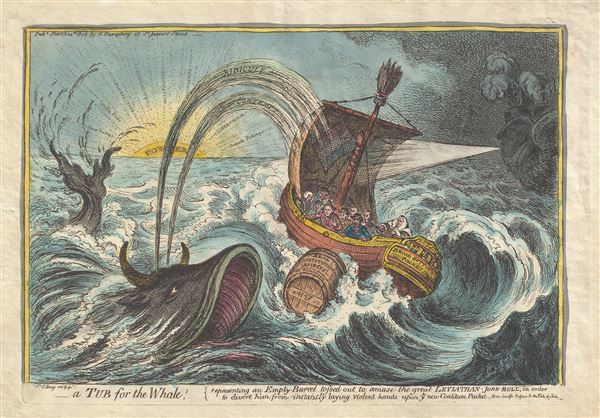This item has been sold, but you can get on the Waitlist to be notified if another example becomes available, or purchase a digital scan.
1806 Gillray Political Satirical Aquatint of A Tub for a Whale
TubWhale-gillray-1806
Title
1806 (undated) 10.5 x 14.5 in (26.67 x 36.83 cm)
Description
In the etching, we see a whale with horns – John Bull (based on the personification of England) with a gaping mouth, spouting 'Ridicule' and 'Contempt' towards a packet-boat steered by the new Ministry. The boat apparently includes Erskine, Sheridan, Petty, Grenville, Windham, Spencer, Fox, Grey and Lord Ellenborogh at the tiller. On the far right, a winged cherub, the Prince of Wales, surrounded by heavy clouds blows wind into the sail. The boat, in danger from the churning waters from the whale's tail, has a broken mast with a broom which signifies that the boat was to be disposed of. The crew has just thrown out a barrel with the inscription 'Real Constitutional Spirits – No Maidstone' and the letters MT (empty). On the horizon we see calmer waters and the rising Sun with the inscription 'Power.' The rays of the Sun are 'Cheese Parings,' 'Candle Ends,' 'Pluralities,' 'Dissipation,' 'Sensuality,' 'Libertinism,' 'Private Pickings.' The scene implies that the new ministry has thrown out an empty cask (supposed to represent the promises of the Whigs), and the wind from the cherub will save the boat from the whale and allow it to reach the calmer waters near the horizon.
Swift explains the title of his book A Tale of a Tub in his preface:
At a grand committee, some days ago, this important discovery was made by a certain curious and refined observer, that seamen have a custom when they meet a Whale to fling him out an empty Tub, by way of amusement, to divert him from laying violent hands upon the Ship. This parable was immediately mythologised; the Whale was interpreted to be Hobbes's 'Leviathan,' which tosses and plays with all other schemes of religion and government, whereof a great many are hollow, and dry, and empty, and noisy, and wooden, and given to rotation. This is the Leviathan from whence the terrible wits of our age are said to borrow their weapons. The Ship in danger is easily understood to be its old antitype the commonwealth. But how to analyse the Tub was a matter of difficulty, when, after long inquiry and debate, the literal meaning was preserved, and it was decreed that, in order to prevent these Leviathans from tossing and sporting with the commonwealth, which of itself is too apt to fluctuate, they should be diverted from that game by 'A Tale of a Tub.' And my genius being conceived to lie not unhappily that way, I had the honour done me to be engaged in the performance.This print, published on March 14, 1806 by Hannah Humphrey of 87, St. James's Street, was created by James Gillray.
This is the sole design in publishing the following treatise, which I hope will serve for an interim of some months to employ those unquiet spirits till the perfecting of that great work, into the secret of which it is reasonable the courteous reader should have some little light.
Cartographer
James Gillray (August 13, 1757- June 1, 1815), commonly consider the 'Father of the Political Cartoon' was a British printmaker, engraver, caricaturist, and satirical cartographer active in the late 18th and early 19th centuries. Gillray was born in Chelsea, London and trained as a letter-engraver, an occupation at which he had considerable skill but little interest. Instead he took to spending his time with itinerant theater troops – a pastime that no doubt influenced his later work. After returning to London he was admitted to the Royal Academy. From this point on Gillray was supported primarily through his etchings, most of which were published by Miss Hannah Humphrey. Although Gillray and Humphrey lived together for many years, they curiously never married. The main corpus of his influential work was published between 1792 and 1810. His popular caricatures, of which there are between 1000 and 1700, typically took the form of political satire. In late middle age Gillray's eyesight began to deteriorate due to alcoholism. It is also said that, while working on his last plate, Interior of a Barber's Shop in Assize Time he descended into insanity, although the nature of his supposed 'madness' is unclear. Nonetheless, after this piece, dated 1811, he produced no further work. He died in 1815 shortly before the Battle of Waterloo. Much of Gillray's work was profane in nature and suppressed, until reissued in 1851 by George Bohn. More by this mapmaker...

